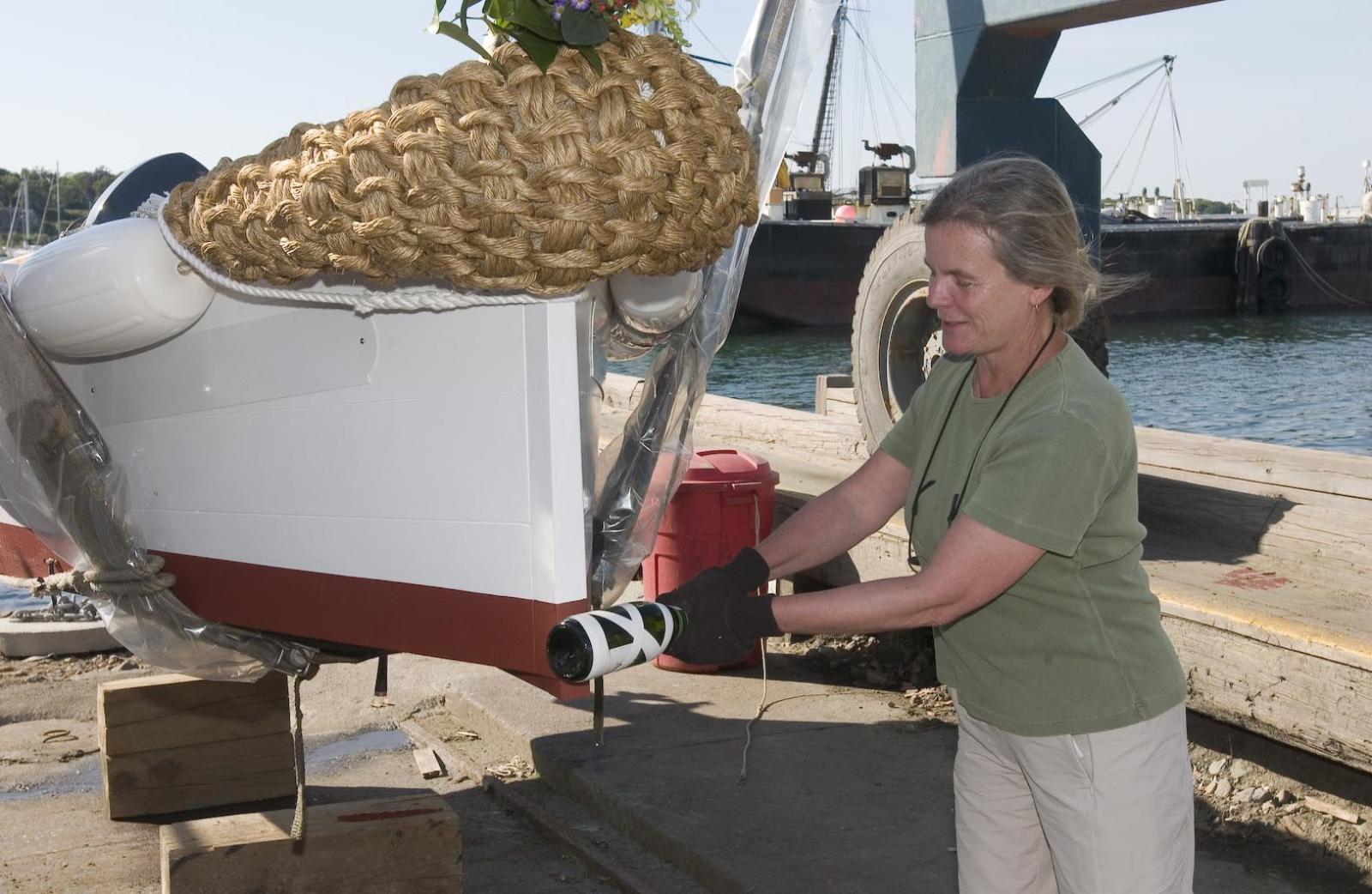A small group of boat enthusiasts gathered at Martha’s Vineyard Shipyard for the launching of a wooden skiff last Friday afternoon.
Unlike most significant boat christenings and launchings, this one didn’t call for a lot of ceremony. There were no speeches, no flags or banners flying. A bottle of champagne was present, but no one was interested in consuming it. Only 20 people were in the audience.
Though the little boat will be the talk of the waterfront for years to come, there was nothing flashy about the gathering.
The skiff was the first of four boats being built for Sail Martha’s Vineyard, the nonprofit organization now in its 17th year. Sail Martha’s Vineyard provides training and on-the-water experience for young people in the art of safe boat handling.
The wooden skiff is 14 feet in length and made the old-fashioned way, by hand with white cedar planks and white oak frames. There is no chrome, no shiny gel coat finish, no aluminum and very little stainless steel. The hull is white and the bottom is red. A bouquet of flowers sat on the bow, along with the rope, tugboat-like bumper that mariners call “pudding.”
The boat was called L.M. Yale.
So what was the point?
Peggy Schwier, president of Sail Martha’s Vineyard, took the bottle of champagne and swung it hard against the bow. Glass shattered and the bubbly went everywhere.
David Spooner, a worker at the shipyard, drove the travel lift and with the smoothness of hydraulics put the boat gently into the water.
Once in the water Phil Hale, president of Martha’s Vineyard Shipyard, fired the boat yard’s brass starting gun. The smoke shot into the air and the noise echoed through the outer harbor. There was applause.
The flat-iron skiff is the first of four boats being built to give the coaches, teachers and staff of Sail Martha’s Vineyard a way to do their business on the water.
This kind of skiff is not unique in the Vineyard Haven waterfront. They are workhorses.
“When it comes to getting out on the boat, the staff prefers them to any other,” Mr. Hale said. “It is a remarkably seaworthy boat.”
What made this boat different from all the others is how it came to be made. It was funded through a partnership of the citizens of Vineyard Haven, the nonprofit organization and state funds. The money came from $36,000 voted at the Tisbury town meeting this spring from the town’s Community Preservation Fund, which is partially funded by the state. An additional $8,000 was committed by Sail Martha’s Vineyard, along with volunteer help to keep the price down.
Brock Callen, program director of Sail Martha’s Vineyard, said four boats are replacing those that have lived beyond their usefulness. So much of the work done by the nonprofit organization takes place on the water. New platforms were needed for instruction at Sailing Camp Park in the Lagoon Pond.
“Over the years, Sail Martha’s Vineyard has been the recipient of gifts from extraordinary people. They’ve given us old Boston Whalers to use for instruction. We’ve got boats from the Edgartown Yacht Club and the West Tisbury fire department, among others,” said Mr. Callen. “They got a lot of use and we used those boats every year. We reached a point where they were no longer economically viable.”
More than a year ago, the nonprofit started researching ways to fund the purchase of new seaworthy boats. The Community Preservation Act funds, new to Tisbury, were one possibility.
The four identical skiffs are of another age. Their design precedes the use of outboard motors. Back in those days, the skiffs were row boats.
Each of these new boats, however, will get a 15-horsepower, four-stroke outboard motor. They’ll spend most of their time in Lagoon Pond, where Sail Martha’s Vineyard operates a sailboat instruction school in the summer.
“Sail Martha’s Vineyard feels an obligation to do what it can to support wooden boat building on the Island,” Mr. Callen said. “It is a dying industry in other places. These skills aren’t being taught any more, unless it is by Ross Gannon, Nat Benjamin and Rick Brown. Our intent is to preserve the maritime heritage. What better way than to support the wooden boat building industry here?”
Rick Brown, of Far Cry Boats, is building all four boats. This week, he is completing the second of the flat-iron skiffs. He said he hopes to deliver the boat to Martha’s Vineyard Shipyard by the end of this week.
On Friday, he stood with his wife Jeri and watched the boat go into the water. He designed and built the boat in his little unassuming shop at Maciel Marine, not far from the water.
Mr. Brown started building boats in 1974. He has made somewhere between 75 and 80 boats, measuring anywhere from as little as six feet in length to as large as 40 feet in length.
He said flat-bottom skiffs draw very little water and are easy to take just about anywhere. He said he plans to finish the last of the four boats by the middle of the summer.
The first of the skiffs is named for a schooner built in Holmes Hole and launched on August 30, 1849. She sailed from the Vineyard on Oct. 15, 1849 and arrived in San Francisco on March 15, 1850. The California gold rush started in 1849.
Nat Benjamin, a wooden boat builder from Gannon and Benjamin Marine Railway, came Friday to watch the launch.
“This is a lovely looking vessel,” Mr. Benjamin said. “What is not to be liked about a beautiful boat, and a beautiful day?”







Comments
Comment policy »